Early Childhood Education & Care: Transition & Behavior Analysis
VerifiedAdded on 2021/09/08
|7
|1473
|174
Report
AI Summary
This report provides an analysis of an article focused on planning transitions to prevent challenging behaviors in early childhood education and care settings. The author examines the article's discussion of how clear transition frameworks can mitigate challenging behaviors, criticizing the potential oversight of child-oriented schedules. The report poses critical questions regarding the disadvantages of revised transition schedules, their accommodation of children with special needs, and their flexibility. It highlights the article's strengths, such as the presentation of transition tips and the advantages of revised schedules, while also noting its limitations, including the lack of discussion on disadvantages and the specific needs of children with special needs. The report concludes by emphasizing the importance of incorporating transition planning into early childhood education and care training for teachers and advocates for a more comprehensive approach to address the diverse needs of all children in a preschool environment. The report uses several references to support the arguments made in the analysis.
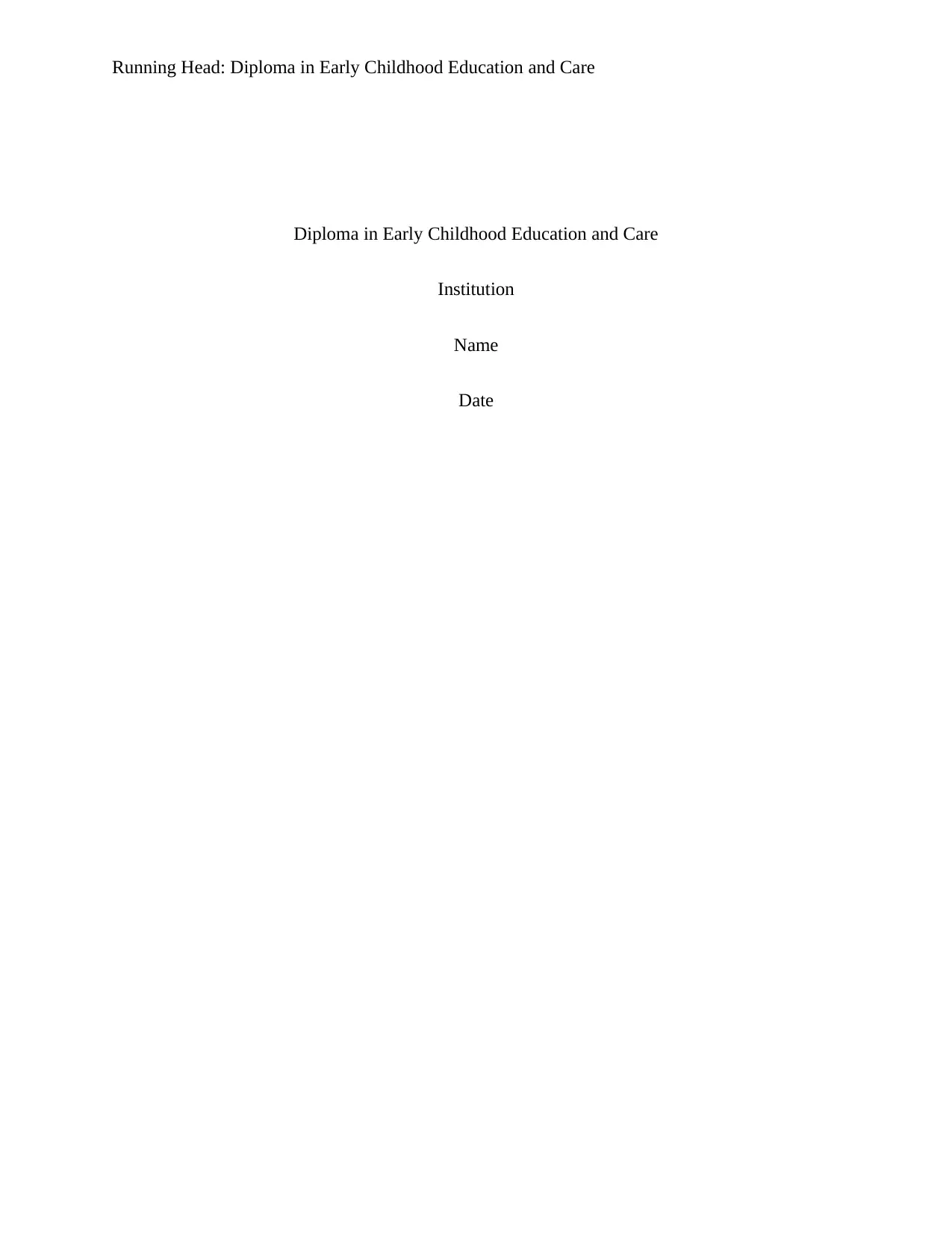
Running Head: Diploma in Early Childhood Education and Care
Diploma in Early Childhood Education and Care
Institution
Name
Date
Diploma in Early Childhood Education and Care
Institution
Name
Date
Paraphrase This Document
Need a fresh take? Get an instant paraphrase of this document with our AI Paraphraser
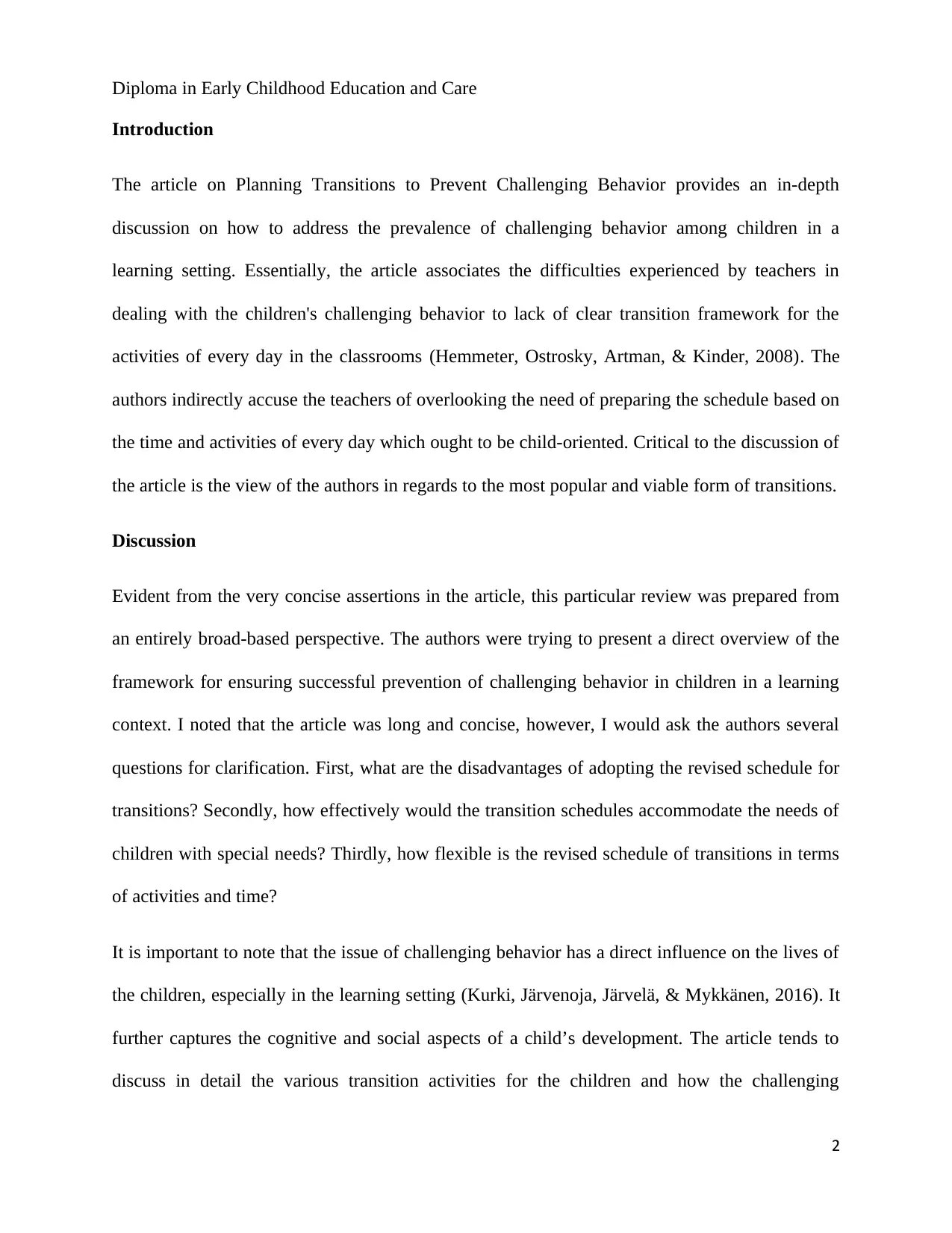
Diploma in Early Childhood Education and Care
Introduction
The article on Planning Transitions to Prevent Challenging Behavior provides an in-depth
discussion on how to address the prevalence of challenging behavior among children in a
learning setting. Essentially, the article associates the difficulties experienced by teachers in
dealing with the children's challenging behavior to lack of clear transition framework for the
activities of every day in the classrooms (Hemmeter, Ostrosky, Artman, & Kinder, 2008). The
authors indirectly accuse the teachers of overlooking the need of preparing the schedule based on
the time and activities of every day which ought to be child-oriented. Critical to the discussion of
the article is the view of the authors in regards to the most popular and viable form of transitions.
Discussion
Evident from the very concise assertions in the article, this particular review was prepared from
an entirely broad-based perspective. The authors were trying to present a direct overview of the
framework for ensuring successful prevention of challenging behavior in children in a learning
context. I noted that the article was long and concise, however, I would ask the authors several
questions for clarification. First, what are the disadvantages of adopting the revised schedule for
transitions? Secondly, how effectively would the transition schedules accommodate the needs of
children with special needs? Thirdly, how flexible is the revised schedule of transitions in terms
of activities and time?
It is important to note that the issue of challenging behavior has a direct influence on the lives of
the children, especially in the learning setting (Kurki, Järvenoja, Järvelä, & Mykkänen, 2016). It
further captures the cognitive and social aspects of a child’s development. The article tends to
discuss in detail the various transition activities for the children and how the challenging
2
Introduction
The article on Planning Transitions to Prevent Challenging Behavior provides an in-depth
discussion on how to address the prevalence of challenging behavior among children in a
learning setting. Essentially, the article associates the difficulties experienced by teachers in
dealing with the children's challenging behavior to lack of clear transition framework for the
activities of every day in the classrooms (Hemmeter, Ostrosky, Artman, & Kinder, 2008). The
authors indirectly accuse the teachers of overlooking the need of preparing the schedule based on
the time and activities of every day which ought to be child-oriented. Critical to the discussion of
the article is the view of the authors in regards to the most popular and viable form of transitions.
Discussion
Evident from the very concise assertions in the article, this particular review was prepared from
an entirely broad-based perspective. The authors were trying to present a direct overview of the
framework for ensuring successful prevention of challenging behavior in children in a learning
context. I noted that the article was long and concise, however, I would ask the authors several
questions for clarification. First, what are the disadvantages of adopting the revised schedule for
transitions? Secondly, how effectively would the transition schedules accommodate the needs of
children with special needs? Thirdly, how flexible is the revised schedule of transitions in terms
of activities and time?
It is important to note that the issue of challenging behavior has a direct influence on the lives of
the children, especially in the learning setting (Kurki, Järvenoja, Järvelä, & Mykkänen, 2016). It
further captures the cognitive and social aspects of a child’s development. The article tends to
discuss in detail the various transition activities for the children and how the challenging
2
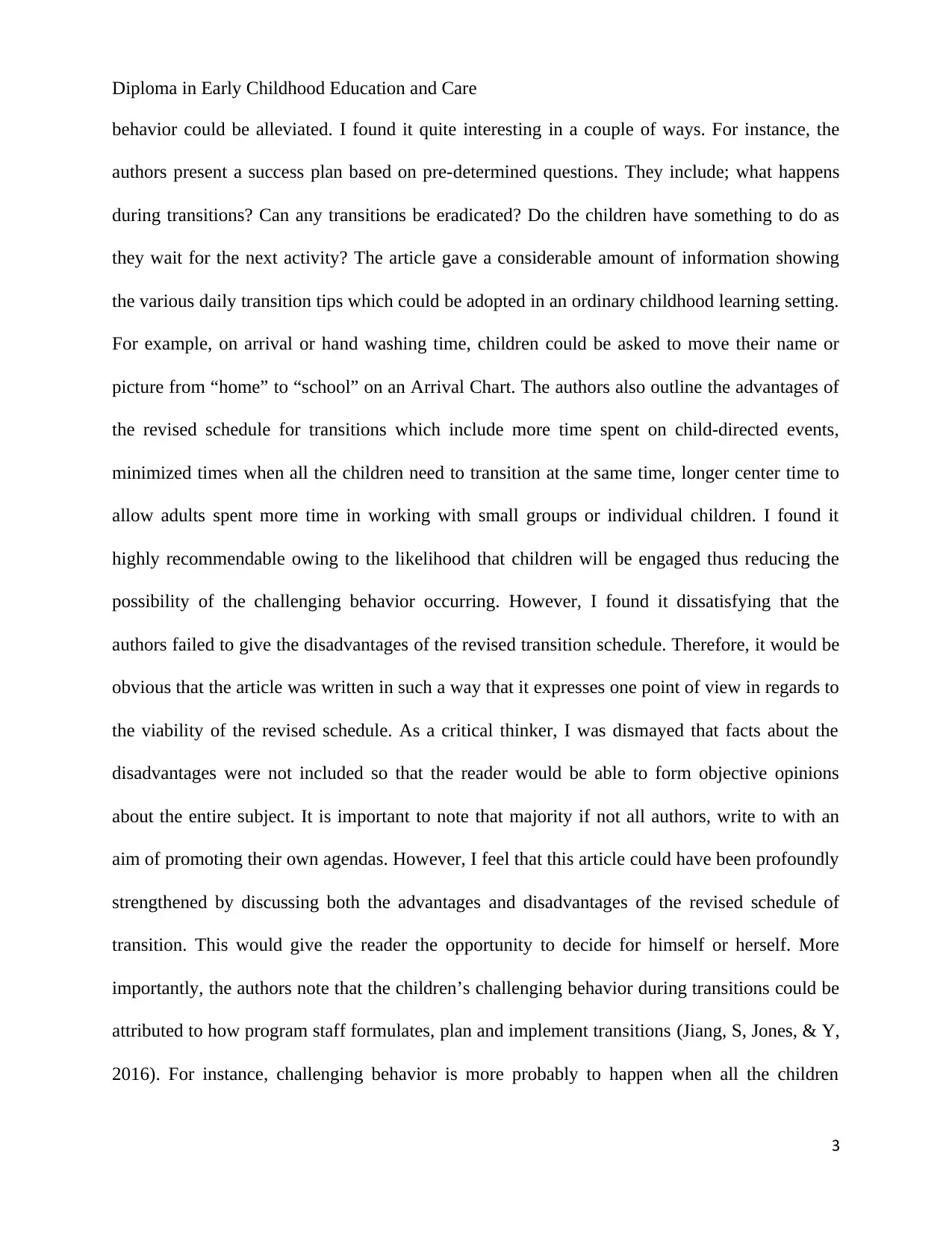
Diploma in Early Childhood Education and Care
behavior could be alleviated. I found it quite interesting in a couple of ways. For instance, the
authors present a success plan based on pre-determined questions. They include; what happens
during transitions? Can any transitions be eradicated? Do the children have something to do as
they wait for the next activity? The article gave a considerable amount of information showing
the various daily transition tips which could be adopted in an ordinary childhood learning setting.
For example, on arrival or hand washing time, children could be asked to move their name or
picture from “home” to “school” on an Arrival Chart. The authors also outline the advantages of
the revised schedule for transitions which include more time spent on child-directed events,
minimized times when all the children need to transition at the same time, longer center time to
allow adults spent more time in working with small groups or individual children. I found it
highly recommendable owing to the likelihood that children will be engaged thus reducing the
possibility of the challenging behavior occurring. However, I found it dissatisfying that the
authors failed to give the disadvantages of the revised transition schedule. Therefore, it would be
obvious that the article was written in such a way that it expresses one point of view in regards to
the viability of the revised schedule. As a critical thinker, I was dismayed that facts about the
disadvantages were not included so that the reader would be able to form objective opinions
about the entire subject. It is important to note that majority if not all authors, write to with an
aim of promoting their own agendas. However, I feel that this article could have been profoundly
strengthened by discussing both the advantages and disadvantages of the revised schedule of
transition. This would give the reader the opportunity to decide for himself or herself. More
importantly, the authors note that the children’s challenging behavior during transitions could be
attributed to how program staff formulates, plan and implement transitions (Jiang, S, Jones, & Y,
2016). For instance, challenging behavior is more probably to happen when all the children
3
behavior could be alleviated. I found it quite interesting in a couple of ways. For instance, the
authors present a success plan based on pre-determined questions. They include; what happens
during transitions? Can any transitions be eradicated? Do the children have something to do as
they wait for the next activity? The article gave a considerable amount of information showing
the various daily transition tips which could be adopted in an ordinary childhood learning setting.
For example, on arrival or hand washing time, children could be asked to move their name or
picture from “home” to “school” on an Arrival Chart. The authors also outline the advantages of
the revised schedule for transitions which include more time spent on child-directed events,
minimized times when all the children need to transition at the same time, longer center time to
allow adults spent more time in working with small groups or individual children. I found it
highly recommendable owing to the likelihood that children will be engaged thus reducing the
possibility of the challenging behavior occurring. However, I found it dissatisfying that the
authors failed to give the disadvantages of the revised transition schedule. Therefore, it would be
obvious that the article was written in such a way that it expresses one point of view in regards to
the viability of the revised schedule. As a critical thinker, I was dismayed that facts about the
disadvantages were not included so that the reader would be able to form objective opinions
about the entire subject. It is important to note that majority if not all authors, write to with an
aim of promoting their own agendas. However, I feel that this article could have been profoundly
strengthened by discussing both the advantages and disadvantages of the revised schedule of
transition. This would give the reader the opportunity to decide for himself or herself. More
importantly, the authors note that the children’s challenging behavior during transitions could be
attributed to how program staff formulates, plan and implement transitions (Jiang, S, Jones, & Y,
2016). For instance, challenging behavior is more probably to happen when all the children
3
⊘ This is a preview!⊘
Do you want full access?
Subscribe today to unlock all pages.

Trusted by 1+ million students worldwide
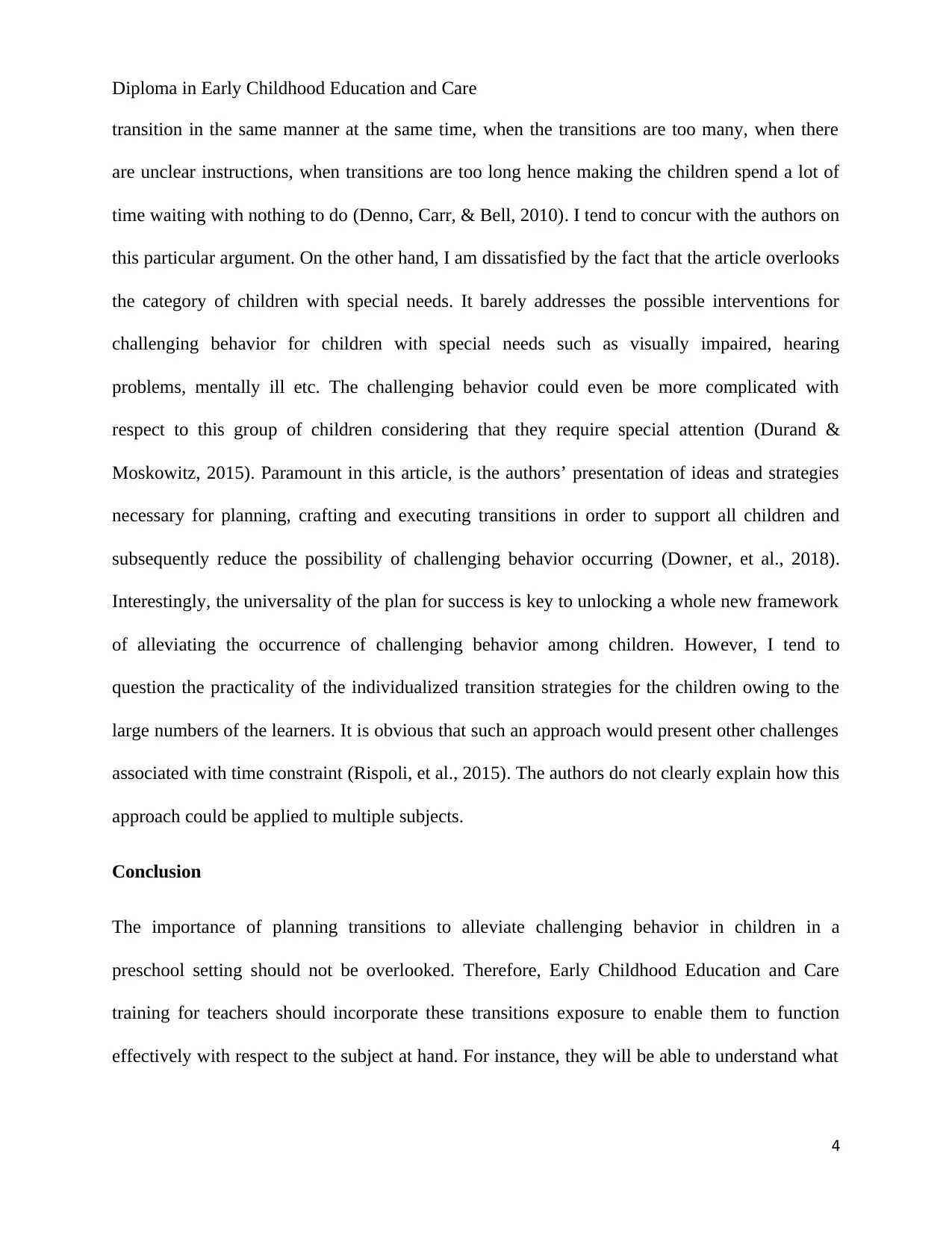
Diploma in Early Childhood Education and Care
transition in the same manner at the same time, when the transitions are too many, when there
are unclear instructions, when transitions are too long hence making the children spend a lot of
time waiting with nothing to do (Denno, Carr, & Bell, 2010). I tend to concur with the authors on
this particular argument. On the other hand, I am dissatisfied by the fact that the article overlooks
the category of children with special needs. It barely addresses the possible interventions for
challenging behavior for children with special needs such as visually impaired, hearing
problems, mentally ill etc. The challenging behavior could even be more complicated with
respect to this group of children considering that they require special attention (Durand &
Moskowitz, 2015). Paramount in this article, is the authors’ presentation of ideas and strategies
necessary for planning, crafting and executing transitions in order to support all children and
subsequently reduce the possibility of challenging behavior occurring (Downer, et al., 2018).
Interestingly, the universality of the plan for success is key to unlocking a whole new framework
of alleviating the occurrence of challenging behavior among children. However, I tend to
question the practicality of the individualized transition strategies for the children owing to the
large numbers of the learners. It is obvious that such an approach would present other challenges
associated with time constraint (Rispoli, et al., 2015). The authors do not clearly explain how this
approach could be applied to multiple subjects.
Conclusion
The importance of planning transitions to alleviate challenging behavior in children in a
preschool setting should not be overlooked. Therefore, Early Childhood Education and Care
training for teachers should incorporate these transitions exposure to enable them to function
effectively with respect to the subject at hand. For instance, they will be able to understand what
4
transition in the same manner at the same time, when the transitions are too many, when there
are unclear instructions, when transitions are too long hence making the children spend a lot of
time waiting with nothing to do (Denno, Carr, & Bell, 2010). I tend to concur with the authors on
this particular argument. On the other hand, I am dissatisfied by the fact that the article overlooks
the category of children with special needs. It barely addresses the possible interventions for
challenging behavior for children with special needs such as visually impaired, hearing
problems, mentally ill etc. The challenging behavior could even be more complicated with
respect to this group of children considering that they require special attention (Durand &
Moskowitz, 2015). Paramount in this article, is the authors’ presentation of ideas and strategies
necessary for planning, crafting and executing transitions in order to support all children and
subsequently reduce the possibility of challenging behavior occurring (Downer, et al., 2018).
Interestingly, the universality of the plan for success is key to unlocking a whole new framework
of alleviating the occurrence of challenging behavior among children. However, I tend to
question the practicality of the individualized transition strategies for the children owing to the
large numbers of the learners. It is obvious that such an approach would present other challenges
associated with time constraint (Rispoli, et al., 2015). The authors do not clearly explain how this
approach could be applied to multiple subjects.
Conclusion
The importance of planning transitions to alleviate challenging behavior in children in a
preschool setting should not be overlooked. Therefore, Early Childhood Education and Care
training for teachers should incorporate these transitions exposure to enable them to function
effectively with respect to the subject at hand. For instance, they will be able to understand what
4
Paraphrase This Document
Need a fresh take? Get an instant paraphrase of this document with our AI Paraphraser
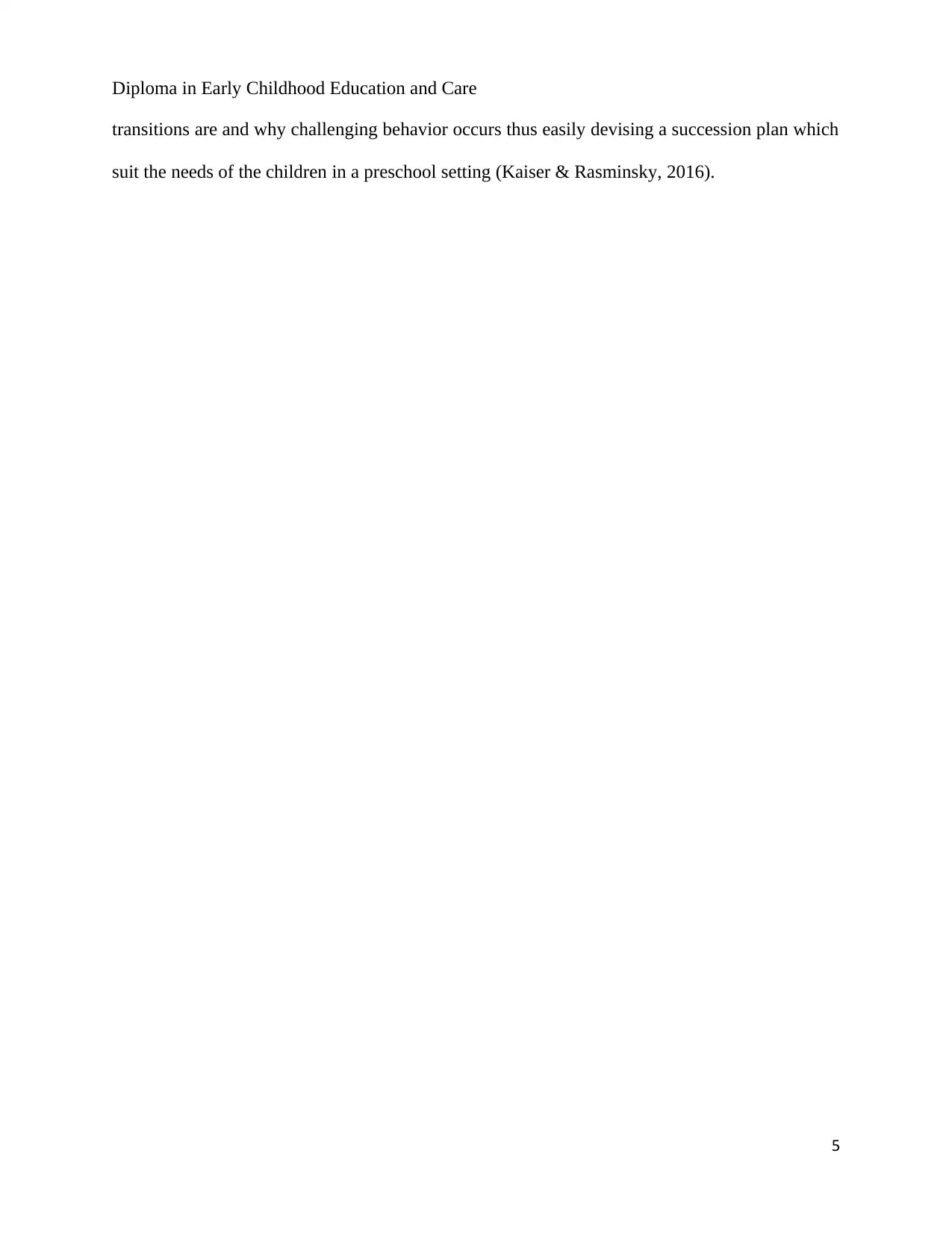
Diploma in Early Childhood Education and Care
transitions are and why challenging behavior occurs thus easily devising a succession plan which
suit the needs of the children in a preschool setting (Kaiser & Rasminsky, 2016).
5
transitions are and why challenging behavior occurs thus easily devising a succession plan which
suit the needs of the children in a preschool setting (Kaiser & Rasminsky, 2016).
5
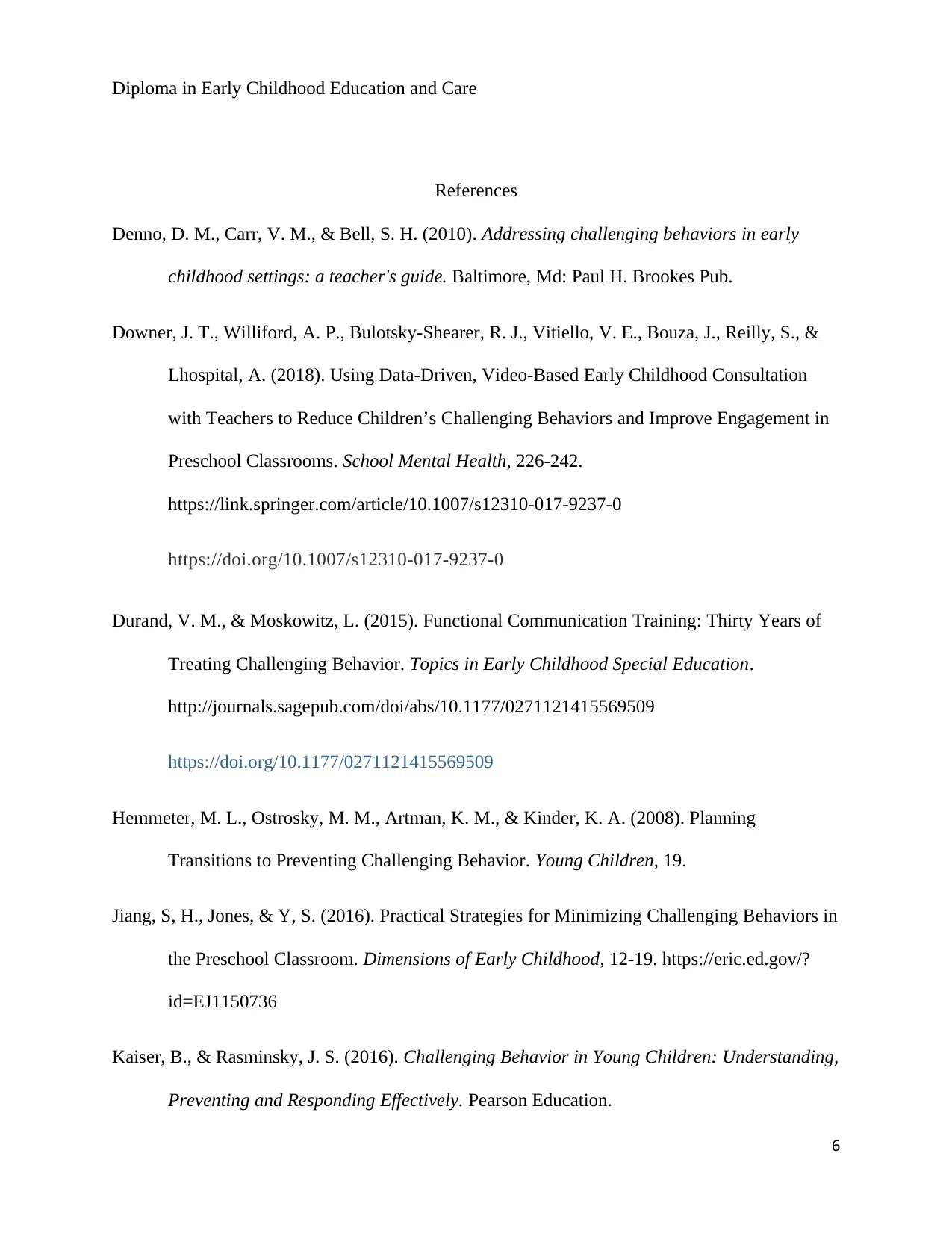
Diploma in Early Childhood Education and Care
References
Denno, D. M., Carr, V. M., & Bell, S. H. (2010). Addressing challenging behaviors in early
childhood settings: a teacher's guide. Baltimore, Md: Paul H. Brookes Pub.
Downer, J. T., Williford, A. P., Bulotsky-Shearer, R. J., Vitiello, V. E., Bouza, J., Reilly, S., &
Lhospital, A. (2018). Using Data-Driven, Video-Based Early Childhood Consultation
with Teachers to Reduce Children’s Challenging Behaviors and Improve Engagement in
Preschool Classrooms. School Mental Health, 226-242.
https://link.springer.com/article/10.1007/s12310-017-9237-0
https://doi.org/10.1007/s12310-017-9237-0
Durand, V. M., & Moskowitz, L. (2015). Functional Communication Training: Thirty Years of
Treating Challenging Behavior. Topics in Early Childhood Special Education.
http://journals.sagepub.com/doi/abs/10.1177/0271121415569509
https://doi.org/10.1177/0271121415569509
Hemmeter, M. L., Ostrosky, M. M., Artman, K. M., & Kinder, K. A. (2008). Planning
Transitions to Preventing Challenging Behavior. Young Children, 19.
Jiang, S, H., Jones, & Y, S. (2016). Practical Strategies for Minimizing Challenging Behaviors in
the Preschool Classroom. Dimensions of Early Childhood, 12-19. https://eric.ed.gov/?
id=EJ1150736
Kaiser, B., & Rasminsky, J. S. (2016). Challenging Behavior in Young Children: Understanding,
Preventing and Responding Effectively. Pearson Education.
6
References
Denno, D. M., Carr, V. M., & Bell, S. H. (2010). Addressing challenging behaviors in early
childhood settings: a teacher's guide. Baltimore, Md: Paul H. Brookes Pub.
Downer, J. T., Williford, A. P., Bulotsky-Shearer, R. J., Vitiello, V. E., Bouza, J., Reilly, S., &
Lhospital, A. (2018). Using Data-Driven, Video-Based Early Childhood Consultation
with Teachers to Reduce Children’s Challenging Behaviors and Improve Engagement in
Preschool Classrooms. School Mental Health, 226-242.
https://link.springer.com/article/10.1007/s12310-017-9237-0
https://doi.org/10.1007/s12310-017-9237-0
Durand, V. M., & Moskowitz, L. (2015). Functional Communication Training: Thirty Years of
Treating Challenging Behavior. Topics in Early Childhood Special Education.
http://journals.sagepub.com/doi/abs/10.1177/0271121415569509
https://doi.org/10.1177/0271121415569509
Hemmeter, M. L., Ostrosky, M. M., Artman, K. M., & Kinder, K. A. (2008). Planning
Transitions to Preventing Challenging Behavior. Young Children, 19.
Jiang, S, H., Jones, & Y, S. (2016). Practical Strategies for Minimizing Challenging Behaviors in
the Preschool Classroom. Dimensions of Early Childhood, 12-19. https://eric.ed.gov/?
id=EJ1150736
Kaiser, B., & Rasminsky, J. S. (2016). Challenging Behavior in Young Children: Understanding,
Preventing and Responding Effectively. Pearson Education.
6
⊘ This is a preview!⊘
Do you want full access?
Subscribe today to unlock all pages.

Trusted by 1+ million students worldwide

Diploma in Early Childhood Education and Care
Kurki, K., Järvenoja, H., Järvelä, S., & Mykkänen, A. (2016). How teachers co-regulate
children's emotions and behavior in socio-emotionally challenging situations in day-care
settings. Educational Research, 76-88.
https://www.sciencedirect.com/science/article/pii/S0883035515304092
https://doi.org/10.1016/j.ijer.2016.02.002
Rispoli, M., Burke, M. D., Hatton, H., Ninci, J., Zaini, S., & Sanchez, L. (2015). Training Head
Start Teachers to Conduct Trial-Based Functional Analysis of Challenging Behavior.
Journal of Positive Behavior Interventions.
http://journals.sagepub.com/doi/abs/10.1177/1098300715577428
https://doi.org/10.1177/1098300715577428
7
Kurki, K., Järvenoja, H., Järvelä, S., & Mykkänen, A. (2016). How teachers co-regulate
children's emotions and behavior in socio-emotionally challenging situations in day-care
settings. Educational Research, 76-88.
https://www.sciencedirect.com/science/article/pii/S0883035515304092
https://doi.org/10.1016/j.ijer.2016.02.002
Rispoli, M., Burke, M. D., Hatton, H., Ninci, J., Zaini, S., & Sanchez, L. (2015). Training Head
Start Teachers to Conduct Trial-Based Functional Analysis of Challenging Behavior.
Journal of Positive Behavior Interventions.
http://journals.sagepub.com/doi/abs/10.1177/1098300715577428
https://doi.org/10.1177/1098300715577428
7
1 out of 7
Related Documents
Your All-in-One AI-Powered Toolkit for Academic Success.
+13062052269
info@desklib.com
Available 24*7 on WhatsApp / Email
![[object Object]](/_next/static/media/star-bottom.7253800d.svg)
Unlock your academic potential
Copyright © 2020–2025 A2Z Services. All Rights Reserved. Developed and managed by ZUCOL.




